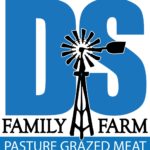Worried about what you are "really" eating? Have peace of mind with pasture grazed meats.
Grazing Through A Dry Summer
For most of the 2022 summer, our pasture has not been in a “drought” as defined by the U.S. Drought Monitor. At the end of August, we have slipped into the category of “D1 – Moderate Drought”. We are thankful for the timely rains that have kept us out of the “drought” category for most of the 2022 growing season. With the New Water Year just one month away, we are starting to think about our 2023 grazing year. How much grass will grow in 2023? Soil moisture conditions on October 1 will give us an indication of what to expect for grass in 2023. This will be the second year in a row that we could enter a new water year with “low” soil moisture conditions. We did notice reduced pasture production this growing season due to low soil moisture at the beginning of the last water new year, October 1, 2021.

Grazing Warm Season Grasses
The 2022 Pasture Grazed Beef looked great coming off our pasture this month. Timely rains, predominantly warm season pastures and, our management, took us through the dry grazing season just fine. Warm season native grasses such as Big Bluestem, Indiangrass, Switch Grass and, Little Bluestem (Nebraska State Grass) are known as “C4” plants (more info concerning C3 vs. C4 plants). Carbon 4 (C4) plants thrive when it is hot and dry, therefore known as “warm season” plants. Carbon 3 (C3) plants are called “cool season” plants and do better during the cool wet periods. We want both C3 and C4 plants in our pastures for diversity, to take advantage of our entire growing season that cycles from cool spring to hot summers to cool falls. But when we are managing pasture grazed beef through our hot dry summers, warm season grasses are critical.
Heeding The Experts
Before starting our 100% Grass-fed / Grass Finished beef herd, we researched what the experts were saying. The experts warned that it would be difficult to finish or get beef fat, on warm season perennial grass. This information was valuable! Over the years we have learned to adapt our grazing management to utilize warm season grass to finish and fatten beef in our environment.

A Flavor Unique To Our Farm
You are invited to taste the difference of grass-fed beef, what we call “Pasture Grazed Beef“. Many of our customers, in search of grass finished beef, come to us for health reasons. These customers return because of the taste and flavor. Flavor comes from fat. The grass fat from our pastures has a unique flavor to our farm and this area of Nebraska.
Why is Flavor so important?





